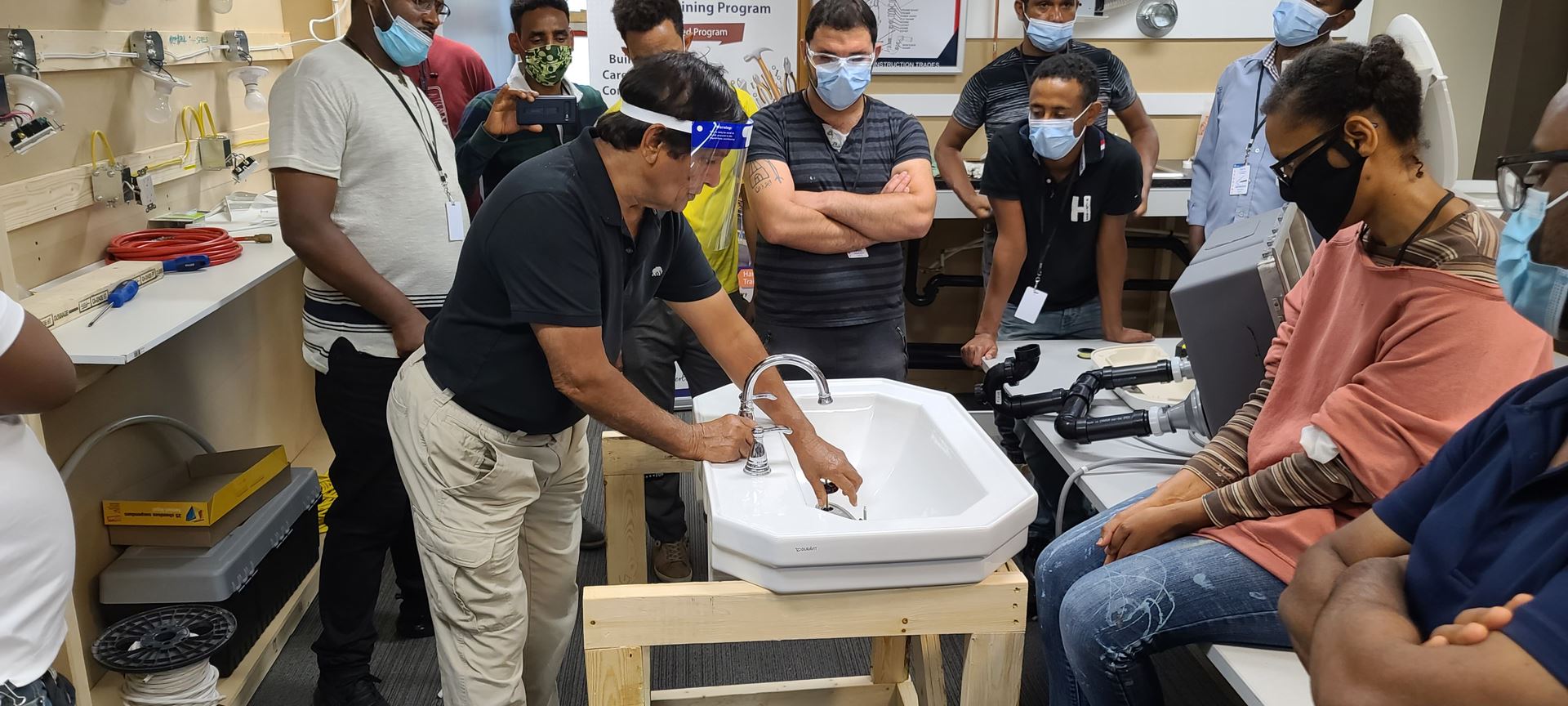This article was produced as part of the Inclusive Journalism Microcredential offered by New Canadian Media and Seneca Polytechnic. Learn more here.
Canada’s new category-based immigration stream will make it easier for economic migrants and students to find work in the trades at a time when the country faces a shortage of skilled tradespeople, say immigration consultants, trade boards, and settlement agencies.
And while the new program may make it easier for some newcomers to get permanent resident status in Canada, addressing the nation’s already complex trade certification process is a critical priority.
Although Canada already has an immigration pathway for tradespeople, the Federal Trades Skilled Program (FTSP), Atul Jagga, a Toronto-based immigration consultant, believes this new selection process might work better because of less stringent requirements and strategic programming.
“Unlike FSTP, which accepts nearly 100 occupations as skilled trades under Canada’s National Occupational Classification (NOC) code, the new system prioritizes only a handful of occupations recognized by the NOC. So every year, the occupations will be reviewed to assess the latest labour market needs,” he shared with NCM in a phone interview.
Jagga hopes that this program will motivate people from other countries to work in trades like carpentry and plumbing, which are often stigmatized. “Somebody who’s an electrician in India might come as a student in Canada can still hope to be a permanent resident based on his experience back home.”
One-in-four job vacancies in Canada is in the trades: of the 818,195 vacancies at the end of the second quarter of 2023, 149,710 were in trades, transport, and equipment operations, according to Statistics Canada. What’s more is that another 700,000 tradespeople are expected to retire by 2028.
To address this issue, on May 31, 2023, Canada launched a new category-based immigration stream, targeting people with experience in priority jobs that include specific trades, healthcare, STEM, transport, and agriculture, as well as French-language speakers. The first draw, inviting 1,500 tradespeople to apply, was held three days later.
But addressing Canada’s labour shortages in trades is complex and multifaceted. Tingting Zhang, a junior policy analyst at the CD Howe Institute, said trades are still stigmatized for being physically demanding and somewhat low-paying.
“This understanding of skilled trades often comes from teachers and parents, who have outdated stereotyped views of the jobs and influenced youths’ career choices in skilled trades,” she said in a research document. “The truth is journeypersons earn more than workers in many industries and many trades offer comprehensive training and paid apprenticeship.”
For example, in 2019, certified tradespeople earned an average of $60,450, with crane operators and technicians earning above $100,000.
“Navigating the journey to becoming a tradesperson can be complicated, with red tape and complex regulatory frameworks identified as key barriers,” a spokesperson from the Toronto Region Board of Trade said in an email. “Addressing these issues is a critical priority, especially given the significant infrastructure investment required to catalyze economic growth in the region.”
Demand for skilled tradespeople continues to remain high: the board added that over the next 10 years, 37,200 construction workers will be required in the Greater Toronto Area alone to meet the demands of both new and retiring workers.
“Many skilled tradespeople are nearing retirement, and there aren’t enough younger workers entering the trades to replace them,” said Rocco Rossi, president and CEO of the Ontario Chamber of Commerce, in an emailed statement. “Additionally, there’s often a societal emphasis on pursuing university education over skilled trades.”
Christopher Worswick, a professor of economics at Carleton University specializing in migration research, worries that large numbers of skilled immigrants who come to Canada and work on low wages might add to existing wage inequalities in sectors like construction, which is already afflicted by poor wage growth.
On a publicly available podcast, Worswick said that the new category-based program would only be meaningful if there were a measure to make sure that skilled people in these trades occupy higher roles, earning higher wages.
Initiatives are being taken at national, provincial, and local levels to address the barriers discouraging newcomers from joining the trades.
“Canada recognizes how important it is that workers, including those from groups facing barriers such as newcomers, get the opportunity to explore and prepare for good careers in the skilled trades,” Mila Roy, spokesperson for Employment and Social Development Canada (ESDC), said via email. “That is why we are investing nearly $1 billion annually in apprenticeship support through grants, loans, tax credits, Employment Insurance benefits, and project funding.”
In an email, a spokesperson from workers’ union CUPE highlighted other challenges newcomers could face.
“Newcomers face possible wage and job discrimination, and they experience to an even greater degree all the challenges and stresses that other residents of Canada face around housing shortages, rising prices and wages that don’t keep up with inflation,” they said. “Governments at all levels must act to offer both immediate relief and long-term solutions to help newcomers settle and thrive in Canada.”
The funding will also go towards Canada’s Red Seal program, which sets common standards to assess tradespeople, and will dovetail with ESDC’s Canadian Apprenticeship Strategy (CAS), which has four key policy objectives: promote the skilled trades as a good career option; support development of initiatives that help succeed in apprenticeship; facilitate participation of employers and unions in apprenticeship; and encourage innovative tools and approaches to prepare for the jobs of tomorrow.
Settlement agencies also offer pre-arrival programs to trade workers approved for immigration, but are still overseas, enabling them to prepare for licensure and have a career plan.
“By doing that, newcomers are able to arrive better prepared and with the documentation they need, as well as explore different settling options if they wish to do so,” emailed Sharvari Jois, director of online and mentoring services at JVS Toronto, which runs the newcomer pathways to skilled trades program, enabling people to navigate Ontario’s Trades Equivalency Assessment process, eliminating barriers and accelerating certification.
In Alberta, the Calgary Catholic Immigration Society’s government-funded CCIS YYC Trades Training program engages with industry representatives to address workforce shortages.
“Our services are not just about job training; they are about changing generations and ensuring that the new wave of tradespeople can thrive and excel in their new home,” said Bob Khan, in director of operations for trades programs, via email. “Since 2001, we have fully trained over 2,500 clients who are now contributing to the province’s economy.”
Canada’s category-based selection program for people in the trades, meanwhile, will run alongside its existing Federal Skilled Trades Program (FTSP).
“The Federal Skilled Trades Program is a permanent program, whereas category-based selection is a selection mechanism within Express Entry where categories are reviewed annually and designed to respond as economic priorities,” said Mary Rose Sabater, communications advisor at Immigration, Refugees and Citizenship Canada, responding to queries via email. “Categories are reviewed annually based on economic goals, labour market projections, and consultations with a range of partners and stakeholders.”
Gautam is a journalist, editor and content writer skilled in both digital and print media, who brings with him more than a decade of editorial experience across five countries, including Canada and the US. A member of the Canadian Association of Journalists, Gautam worked as Deputy Editor of the Times of Oman before moving to Canada, where he continues to write on healthcare, education, human interest stories, sport, lifestyle, and science and tech. Gautam has a Masters' Degree in journalism from the UK, and is fluent in both English and French. He lives in Toronto.
Amrita is an NCM-CAJ Collective Member, journalist and content writer, with nearly a decade of experience in content development and journalism in three countries. She started her career as a journalist with a leading daily, The Statesman, in India. She has also led content and editorial teams for several web content management firms. Amrita served as a Communications and Content specialist for some non-profit organizations like the American Red Cross after her move to the U.S. Based out of Toronto, she continues to follow her passion by reporting on human rights violations, education, crimes, inequality and community engagement. Amrita holds a Post Graduate Diploma in Print Journalism from Chennai, India.







